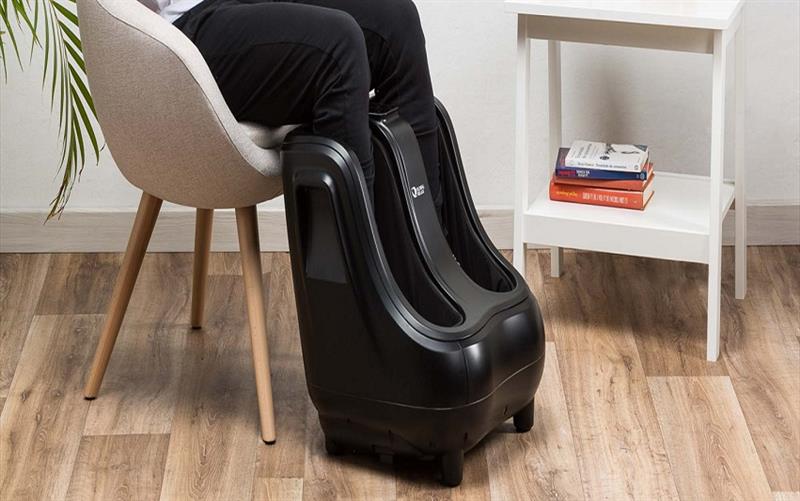
Leg massagers offer a valuable adjunct to post-surgery care, providing numerous benefits such as enhanced circulation, reduced swelling, pain management, muscle recovery, and prevention of complications. However, their integration into the recovery regimen requires careful consideration, including consultation with healthcare providers, proper usage, monitoring for adverse reactions, and complementing other aspects of post-surgery care. By incorporating leg massagers effectively and responsibly, patients can promote healing, improve comfort, and optimize their recovery journey following leg surgeries.
Leg massagers are devices designed to stimulate circulation and relieve tension in the lower extremities through various massage techniques. These devices come in different forms, including air compression sleeves, vibration massagers, and roller-based systems. They typically target key areas such as the calves, ankles, and feet, employing adjustable settings to cater to individual preferences and therapeutic needs.
Benefits of Leg Massagers in Post-Surgery Care:
1. Enhanced Circulation:
Enhanced circulation is another significant benefit of muscle recovery. When muscles are properly rested and allowed to recover after exercise or physical activity, blood flow to those muscles improves. This enhanced circulation delivers oxygen and essential nutrients to the muscles, aiding in their repair and recovery process.
Improved circulation also helps remove metabolic waste products, such as lactic acid, from the muscles more efficiently. This reduces muscle soreness and fatigue, allowing individuals to recover faster and perform better in subsequent activities.
2. Reduced Swelling:
Reduced swelling is another notable benefit of muscle recovery. After intense physical activity or injury, inflammation and swelling often occur as part of the body's natural healing response. However, excessive swelling can impede the recovery process and cause discomfort.
Muscle recovery techniques such as rest, elevation, and gentle movement help facilitate the reduction of swelling. Rest allows the body to divert resources to healing damaged tissues, while elevation helps to minimize swelling by promoting the drainage of excess fluid from the affected area.
3. Pain Management:
Pain management is a crucial aspect of muscle recovery, especially following intense physical activity, injury, or surgery. Effective pain management techniques help alleviate discomfort, improve mobility, and support the body's healing process.
One common pain management strategy is the use of nonsteroidal anti-inflammatory drugs (NSAIDs) such as ibuprofen or aspirin to reduce inflammation and relieve pain. These medications can be helpful in managing acute pain resulting from muscle soreness, strains, or injuries.
4. Muscle Recovery:
Muscle recovery is a crucial aspect of physical fitness and overall well-being. Whether you're an athlete pushing your limits or someone recovering from injury or surgery, understanding and facilitating muscle recovery can significantly impact your performance and quality of life.
Muscle recovery refers to the process by which muscles repair and rebuild themselves after exercise, injury, or other forms of stress. It involves several physiological mechanisms that occur at the cellular level to restore muscle function and structure.
5. Reduced Risk of Injury:
Proper muscle recovery helps reduce the risk of injury by allowing muscles, tendons, and ligaments to heal and regain strength. This is particularly important for athletes who engage in repetitive or high-impact activities that can strain muscles and connective tissues.
Reduced risk of injury is a crucial benefit of engaging in proper muscle recovery techniques and maintaining overall physical health. By taking proactive measures to prevent injuries, individuals can continue to pursue their fitness goals and activities with confidence while minimizing the risk of setbacks.
6. Improved Performance:
Adequate muscle recovery is essential for optimal performance in sports and physical activities. Fully recovered muscles are better able to generate force, endure sustained activity, and maintain proper biomechanics, leading to improved overall performance.
Improved performance is a key goal for athletes, fitness enthusiasts, and individuals seeking to enhance their physical abilities. Whether it's in sports, exercise routines, or everyday activities, optimizing performance can lead to better results and overall satisfaction with one's abilities.
7. Enhanced Flexibility and Range of Motion:
Muscle recovery includes techniques such as stretching and mobility exercises, which can improve flexibility and range of motion. This is beneficial for athletes and individuals engaging in activities that require flexibility, such as yoga, dance, and martial arts.
Enhanced flexibility and range of motion are crucial components of physical health and well-being. Improving flexibility helps prevent injuries, enhances athletic performance, and promotes overall mobility and comfort in daily activities.
8. Mental Restoration:
Muscle recovery is not only physical but also mental. Taking time to rest and recover allows the mind to recharge, reducing mental fatigue and improving focus and concentration during subsequent workouts or activities.
Mental restoration is essential for overall well-being and encompasses practices that promote relaxation, stress relief, and mental rejuvenation. Taking time to unwind and recharge mentally is crucial for managing stress, improving cognitive function, and enhancing emotional resilience.
9. Better Sleep Quality:
Engaging in activities that promote muscle recovery, such as light stretching or foam rolling before bedtime, can contribute to better sleep quality. Improved sleep is associated with enhanced muscle repair, hormone regulation, and overall well-being.
Better sleep quality is essential for overall health and well-being, impacting various aspects of physical, mental, and emotional functioning. Improving sleep quality involves adopting healthy sleep habits and creating a conducive sleep environment to promote restful and rejuvenating sleep.
10. Long-Term Health and Wellness:
Prioritizing muscle recovery as part of a balanced exercise routine contributes to long-term health and wellness. By allowing the body to recover and adapt to physical stress, individuals can sustain their fitness goals while minimizing the risk of overuse injuries and burnout.
Long-term health and wellness are essential goals for maintaining a high quality of life and overall well-being. By adopting healthy lifestyle habits and prioritizing self-care, individuals can proactively support their physical, mental, and emotional health for the long term.